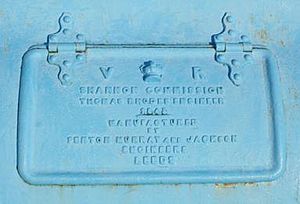Fenton, Murray and Jackson facts for kids
 |
|
| General partnership | |
| Industry | Engineering Heavy industry |
| Fate | Out of business |
| Successor | Fenton, Murray and Jackson |
| Founded | 1790s |
| Founder | David Wood Matthew Murray |
| Defunct | 1843 |
| Headquarters | Round Foundry,
Holbeck, Leeds
,
|
|
Key people
|
James Fenton William Lister Joshua Routledge Benjamin Hick Benjamin Cubitt Charles Todd John Chester Craven Richard Peacock David Joy |
Fenton, Murray and Jackson was an important engineering company. It was located at the Round Foundry in Holbeck, Leeds, West Yorkshire, England. This company played a big part in the early days of the Industrial Revolution. They built many different kinds of machines.
Contents
Early Days: Fenton, Murray and Wood
The company first started in the 1790s. It was called Fenton, Murray and Wood. It was founded by Matthew Murray, who was good at working with iron, and David Wood, an engineer who designed machines for making textiles (like cloth).
Their main goal was to build machine tools. These are machines that make other things. They mostly made tools for the textile industry. They also built stationary steam engines. These were powerful engines that stayed in one place to power factories.
The company got its money from James Fenton. He owned a colliery (a coal mine) and was the main person who invested in the business. William Lister, a millwright (someone who builds or fixes mills), was also a partner. He was a sleeping partner, meaning he invested money but didn't work in the daily business.
Building Early Locomotives
In 1811, an inventor named Blenkinsop got a special patent. This patent was for a rack-and-pinion system for trains. This system used a toothed wheel (pinion) that fit into a toothed rail (rack). It helped trains climb steep hills.
Fenton, Murray and Wood were asked to design a locomotive that used this new idea. In 1812, they built a successful train engine called Salamanca. It was one of the first working steam locomotives. The company built a total of six of these engines. Matthew Murray, one of the founders, passed away in 1826.
Later Years: Fenton, Murray and Jackson
After David Wood died in 1820, the company changed its name. It became Fenton, Murray and Jackson.
In 1824, the company supplied a large 60-hp beam engine. This was a type of steam engine with a big rocking beam. It was used to pump water away from Deeping Fen, a marshy area. This engine was named Kesteven and worked for over 100 years, until 1925!
From 1831, the company started building locomotives designed by Robert Stephenson. These included "Planets" (which had a 2-2-0 wheel setup) and "Patentees" (with a 2-2-2 wheel setup). Many of these were built as subcontracts, meaning they built them for other companies.
Many of these locomotives were sent to other countries. They also built twenty of the Firefly class engines for the Great Western Railway. By 1840, Fenton, Murray and Jackson were building up to twenty train engines every year.
The End of the Company
You can still see the company's name today! Their name appears on cast iron bollards (short posts) at Victoria Lock. This lock was built in 1843 on the River Shannon in Ireland. The bollards say "Fenton, Murray and Jackson Engineers of Leeds."
However, by 1843, the big demand for new engines slowed down. The company closed its doors that year.

